The art of arterial revascularization—total arterial revascularization in patients with triple vessel coronary artery disease
Abstract
The use of the left internal thoracic artery to graft the left anterior descending artery has been widely accepted as the gold standard for surgical treatment of coronary disease for over 40 years. However the use of multiple other arterial grafts to support this has not been accepted readily, in spite of evidence of superiority over saphenous vein grafts, probably because of perceptions of technical complexity, time constraints for conduit harvesting and increased peri-operative complications. As a result, even today most patients with multivessel coronary artery disease do not receive the potential benefits of extensive or total arterial revascularization. We discuss here the use of contemporary techniques and grafts configurations to simplify this, and the safety and benefit data underpinning this practice. Current patency data confirm that a left internal thoracic artery graft performs well beyond 20 years, with over 80% freedom from failure, but accumulating data suggest that the right internal thoracic artery behaves in the same way. Radial artery grafts are being studied in several randomized trials, but observational studies already suggest a performance which compares favourably with saphenous vein. Total arterial revascularization is achievable in most patients with a small but acceptable increase in risk of sternal complications when certain defined subgroups are excluded.
Cover






